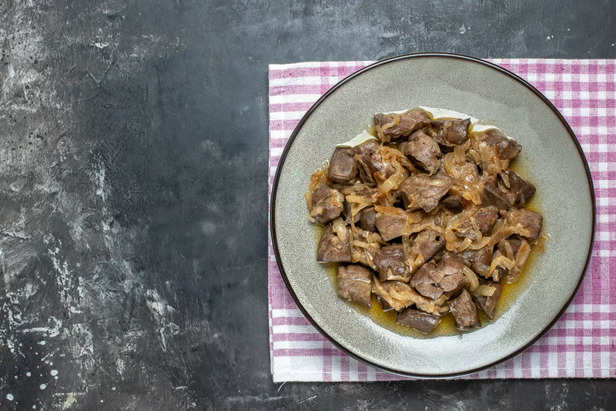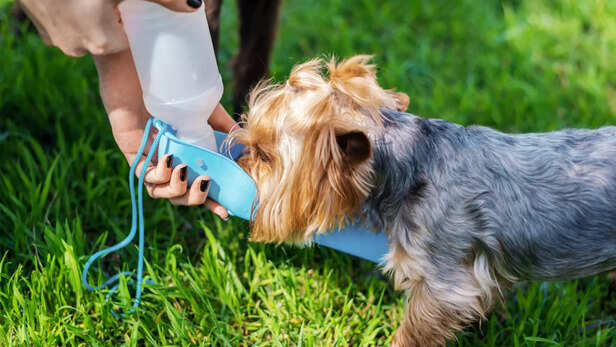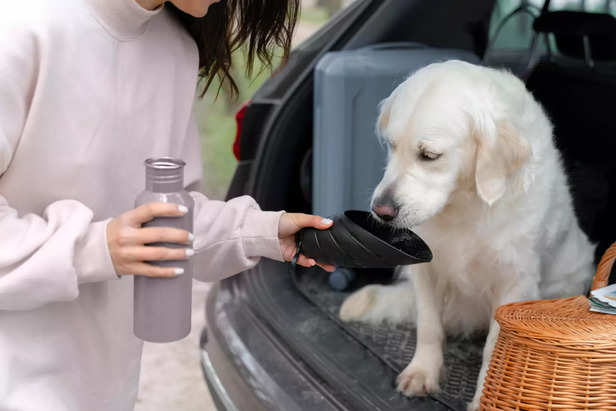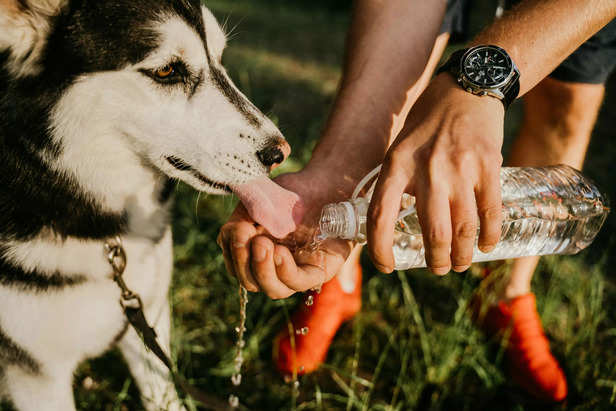Hydration Tips for Pets - How to Encourage Them to Drink Water When They Dislike It
Nikita Kanyal | Jan 16, 2025, 10:16 IST

Is your pet not consuming enough water? Don’t worry! We have easy, creative strategies to improve hydration for even the pickiest pets. Whether it’s adding tasty flavors, using fun water toys, or moving bowls to new spots, we will show you how to make drinking water enjoyable and effective. Keep your cherished friend happy, healthy, and hydrated easily with these simple tips!
Ensuring your furry companions remain adequately hydrated is one of the most vital actions you can take for their well-being. Nevertheless, numerous pets show little interest in consuming water, regardless of how warm or parched they may feel. If your pet declines water bowls or won't maintain their hydration, you’re not the only one. Luckily, there are successful approaches to guarantee your pet receives sufficient fluids, promoting their health, happiness, and vitality.
Why Hydration Matters for Pets
First things first—why is hydration so important for your pet? Just like humans, pets need water to regulate their body temperature, support vital functions, and keep their organs functioning properly. Dehydration can lead to serious health problems, including kidney issues, urinary tract infections, and lethargy. Even mild dehydration can leave your pet feeling sluggish and uncomfortable.
Dogs and cats may not always show obvious signs of thirst, so it’s easy to overlook their hydration needs. In fact, many pets are notoriously bad at drinking enough water on their own, especially in colder months or if they’ve switched to a diet with more wet food. But don’t worry—getting your pet to drink more water doesn’t have to be a battle. Let’s dive into some simple, creative methods to encourage hydration.
1. Switch to Wet Food or Add Moisture to Their Diet

One of the easiest ways to increase your pet’s water intake is by adjusting their diet. Pets who eat dry food are at a higher risk of dehydration since dry kibble doesn’t provide much moisture. Opting for wet food, like canned dog or cat food, is a game-changer. Wet food contains higher water content, helping to keep your pet hydrated from the inside out.
If your pet prefers dry food, you can also try mixing in a bit of water or pet-safe bone broth to make their kibble more appealing. The added moisture will boost their fluid intake without relying solely on a water bowl.
2. Flavor It Up!

Let’s face it—plain water can be pretty boring for pets. If your furry friend turns their nose up at the water bowl, try jazzing things up a bit. Adding low-sodium broth, tuna water, or even a splash of chicken broth can make water more enticing. The key is to avoid anything high in salt or artificial flavors that might be harmful to your pet.
Some pets also prefer running water or fountains, so consider investing in a pet water fountain. The constant flow and gentle stream can be more appealing than a still water bowl, encouraging your pet to drink more.
3. Get Creative with Treats and Toys

Why not make hydration fun? There are tons of interactive water toys and dispensers designed to encourage pets to drink more. For example, puzzle feeders that dispense water can keep dogs engaged and motivated to drink. Some cats love drinking from a dripping faucet or a pet-friendly water fountain that simulates the sound of running water.
You can also freeze water into ice cubes with pet-safe flavors like meat or fish, turning water into a fun, cool treat on a hot day. Pets are often more willing to drink something that feels novel and refreshing.
Pets are curious creatures, and sometimes they just need a little variety. If your pet isn’t drinking enough water, try offering water bowls in different locations around the house. Some pets prefer drinking from a bowl near their favorite spot, like a cozy corner or their sleeping area. Others might be more inclined to drink in the kitchen or bathroom where they associate hydration with mealtime.
For dogs, walking outside with a portable water bowl during playtime can encourage them to drink while they’re out and about. Cats may prefer fountains or bowls placed near windows, offering a quiet, peaceful environment to drink.
5. Make Hydration a Routine

Consistency is key. Just like with feeding schedules, having a set time for offering water can help reinforce hydration habits. Place fresh water bowls in accessible spots and ensure they’re refilled regularly. Try to keep a routine of checking and refilling water bowls at least once or twice a day.
For dogs, especially active ones, keep a portable water bottle and bowl handy during walks or outdoor activities. Cats, who may not naturally drink as much water, can benefit from strategically placed water bowls around their favorite spaces.
6. Monitor Health and Watch for Signs of Dehydration
Monitor your pet’s health and behavior closely. Dehydrated animals might exhibit signs like lethargy, dry gums, sunken eyes, or reduced urination. If you observe any of these symptoms, it’s important to take steps. In extreme cases, dehydration can result in health crises, so do not wait to reach out to a veterinarian if you.
Why Hydration Matters for Pets
Dogs and cats may not always show obvious signs of thirst, so it’s easy to overlook their hydration needs. In fact, many pets are notoriously bad at drinking enough water on their own, especially in colder months or if they’ve switched to a diet with more wet food. But don’t worry—getting your pet to drink more water doesn’t have to be a battle. Let’s dive into some simple, creative methods to encourage hydration.
1. Switch to Wet Food or Add Moisture to Their Diet

Wet food has about 70-80% water content ( Image Source : Pixabay)
One of the easiest ways to increase your pet’s water intake is by adjusting their diet. Pets who eat dry food are at a higher risk of dehydration since dry kibble doesn’t provide much moisture. Opting for wet food, like canned dog or cat food, is a game-changer. Wet food contains higher water content, helping to keep your pet hydrated from the inside out.
If your pet prefers dry food, you can also try mixing in a bit of water or pet-safe bone broth to make their kibble more appealing. The added moisture will boost their fluid intake without relying solely on a water bowl.
2. Flavor It Up!

Tuna water will enhance the taste for your pet ( Image Source : Pixabay)
Let’s face it—plain water can be pretty boring for pets. If your furry friend turns their nose up at the water bowl, try jazzing things up a bit. Adding low-sodium broth, tuna water, or even a splash of chicken broth can make water more enticing. The key is to avoid anything high in salt or artificial flavors that might be harmful to your pet.
Some pets also prefer running water or fountains, so consider investing in a pet water fountain. The constant flow and gentle stream can be more appealing than a still water bowl, encouraging your pet to drink more.
3. Get Creative with Treats and Toys

Make this interesting and fun ( Image Source : Pixabay)
Why not make hydration fun? There are tons of interactive water toys and dispensers designed to encourage pets to drink more. For example, puzzle feeders that dispense water can keep dogs engaged and motivated to drink. Some cats love drinking from a dripping faucet or a pet-friendly water fountain that simulates the sound of running water.
You can also freeze water into ice cubes with pet-safe flavors like meat or fish, turning water into a fun, cool treat on a hot day. Pets are often more willing to drink something that feels novel and refreshing.
4. Serve Water in Different Locations
For dogs, walking outside with a portable water bowl during playtime can encourage them to drink while they’re out and about. Cats may prefer fountains or bowls placed near windows, offering a quiet, peaceful environment to drink.
5. Make Hydration a Routine

Try to incorporate water in your pet's routine ( Image Source : Pixabay)
Consistency is key. Just like with feeding schedules, having a set time for offering water can help reinforce hydration habits. Place fresh water bowls in accessible spots and ensure they’re refilled regularly. Try to keep a routine of checking and refilling water bowls at least once or twice a day.
For dogs, especially active ones, keep a portable water bottle and bowl handy during walks or outdoor activities. Cats, who may not naturally drink as much water, can benefit from strategically placed water bowls around their favorite spaces.
